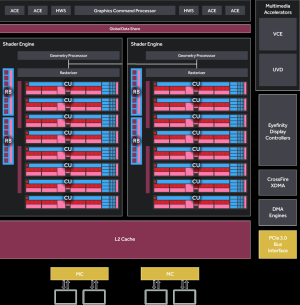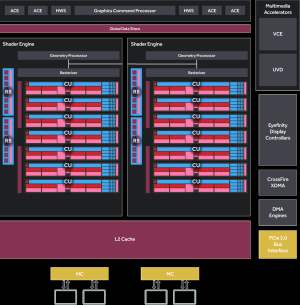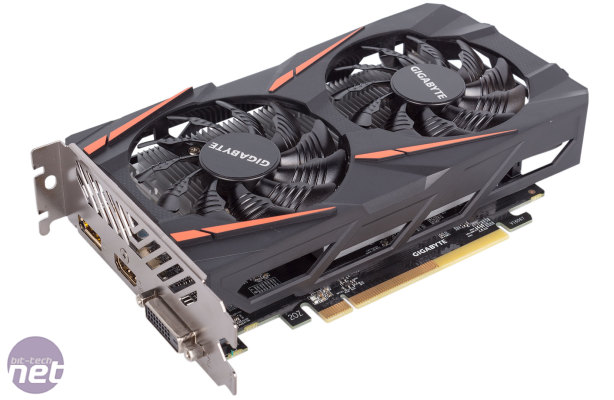Gigabyte Radeon RX 460 WindForce 2X OC 2GB Review
Manufacturer: GigabyteUK price (as reviewed): MSRP £120 (inc VAT)
US price (as reviewed): MSRP $119 (ex Tax)
Mere days after the release of its latest graphics card, the RX 470, AMD is back with another launch that brings its Polaris architecture to the entry-level. AMD's pitch is that the RX 460 is designed to give ageing systems an upgrade to a cool and efficient card capable of >90fps 1080p gameplay in popular esports titles and of future-proofing them as well with a slew of modern display capabilities and features.
Whereas the RX 470 was based on a cut-down version of the Polaris 10 GPU that powers the RX 480, the RX 460 is using a new, significantly smaller chip known as Polaris 11. The die size is a measly 123mm2, which is almost half the size of a GTX 1060 or RX 480 GPU. Even so, AMD manages to cram in 3 billion transistors, and you can get an idea of how these are arranged in the block diagram below.
This is a far smaller implementation of GCN than we're used to seeing, although the design principles and arrangement are all familiar. At the front end there's the usual Graphics Command Processor and pair of Hardware Schedulers, as well as four Asynchronous Compute Engines – until now we've been used to eight here. These are used to dispatch graphics and compute tasks in parallel and we've seen them give AMD an edge in DirectX 12 applications as a result. Polaris brings with it extra asynchronous compute functions, but these will be of limited benefit to a card of this calibre – the focus clearly isn't on maximising performance in the latest DX12 titles.


Click to enlarge - The full Polaris 11 die block shot (left) and its implementation in the RX 460 (right)
The main pipeline is still arranged into Shader Engines, each with its own geometry processor, rasteriser, Compute Units and Render Backend units. For Polaris, the geometry processor has had some tweaks to better handle heavily tessellated scenes, but the main hardware blocks are unchanged from what we've seen before. In this GPU there are eight Compute Units per SE, but for the RX 460 two of these are disabled leaving it with just 14 in total, which is less than half the count found in the RX 470. This leaves it with a stream processor count of 896 and 56 texture units. Four of AMD's Render Backend units mean we're looking at a card with just 16 ROPs – a card for high resolution gaming this is not. The GPU is set at a base clock of 1,090MHz and a boost clock of 1,200MHz.
In terms of memory, the card has a 1MB internal L2 cache. As for the external GDDR5, there will be two designs: one 2GB and one 4GB. In both instances this will be clocked at 1.75GHz (7Gbps effective), netting us a total memory bandwidth of 112GB/sec over the 128-bit interface. This is only the raw bandwidth – Polaris benefits from AMD's latest delta colour compression algorithms, allowing this card to make better use of the available bandwidth than previous generation products. 2GB of memory feels like a bit of squeeze these days, even at 1080p, but it's likely enough to cope with the low demands of esports titles.
| AMD Radeon RX 480 | AMD Radeon RX 470 | AMD Radeon RX 460 | AMD Radeon R7 370 | |
| GPU | ||||
| Architecture | GCN 4th Gen | GCN 4th Gen | GCN 4th Gen | GCN 1st Gen |
| Codename | Polaris 10 | Polaris 10 | Polaris 11 | Trinidad Pro |
| Boost Clock | 1,266MHz | 1,206MHz | 1,200MHz | 975MHz |
| Base Clock | 1,120MHz | 926MHz | 1,090MHz | 925MHz |
| Stream Processors | 2,304 | 2,048 | 896 | 1,024 |
| Layout | 4 SEs, 36 CUs | 4 SEs, 32 CUs | 2 SEs, 14 CUs | 2 SEs, 16CUs |
| Texture Units | 144 | 128 | 56 | 64 |
| Rasterisers | 4 | 4 | 2 | 2 |
| Tesselation Units | 4 | 4 | 2 | 2 |
| ROPs | 32 | 32 | 16 | 32 |
| Transistors | 5.7 billion | 5.7 billion | 3 billion | 2.8 billion |
| Die Size | 232mm2 | 232mm2 | 123mm2 | 212mm2 |
| Process Node | 14nm | 14nm | 14nm | 28nm |
| Memory | ||||
| Amount | 4GB or 8GB GDDR5 | 4GB or 8GB GDDR5 | 2GB or 4GB GDDR5 | 2GB GDDR5 |
| Frequency | 1.75GHz or 2GHz (7Gbps or 8Gbps effective) | 1.65GHz (6.6Gbps effective) | 1.75GHz (7Gbps effective) | 1.4GHz (5.6Gbps effective) |
| Interface | 256-bit | 256-bit | 128-bit | 256-bit |
| Bandwidth | 224GB/sec or 256GB/sec | 211.2GB/sec | 112GB/sec | 179.2GB/sec |
| Card Specifications | ||||
| Power Connectors | 1 x 6-pin | 1 x 6-pin | None | 1 x 6-pin |
| Stock Card Length | 243mm | N/A | N/A | N/A |
| TDP | 150W | 120W | <75W | 110W |
As a Polaris chip, the new GPU benefits from significant efficiency gains thanks to the 14nm FinFET process. This, coupled with this simply being a small GPU, allows AMD to keep its reference design below a typical board power of 75W, meaning that neither the 2GB or 4GB variants require a supplementary PCI-E power connector to operate. Board partners may still choose to implement one, of course, but for any that don't the RX 460 will be suitable for upgrading older or off-the-shelf PCs that may not have even one spare connector.
The power consumption is low enough that the RX 460 will also find its way into notebooks, with AMD listing the HP Omen as one such example. The GPU will retain its desktop name, and will be competing with the likes of Nvidia's GTX 960M.
Also found in the GPU are AMD's latest video encode and decode units, which now support HEVC (H.265) content. 2-pass encoding is another new feature on the encode side, enabling higher quality fast HQ encodes. The take-home message is that the RX 460 is well equipped to use for streaming.
Reference display connections include one DisplayPort 1.4 connector which is HDR ready, one HDMI 2.0b connector and one DVI-D for legacy panels. FreeSync is support via both DisplayPort and HDMI.
You may also notice that the CrossFire XDMA block is present. The RX 460 supports implicit (CrossFire) and explicit multi-GPU modes in two-way setups only.
While overclocking isn't really a focus for a GPU like this, you are still able to tweak settings in detail using the Radeon WattMan interface, which is accessed via Radeon Settings. This allows you to tune fan speeds, temperature and power limits and, of course, clock speeds and voltages – on a per state basis, if you wish.

MSI MPG Velox 100R Chassis Review
October 14 2021 | 15:04










Want to comment? Please log in.